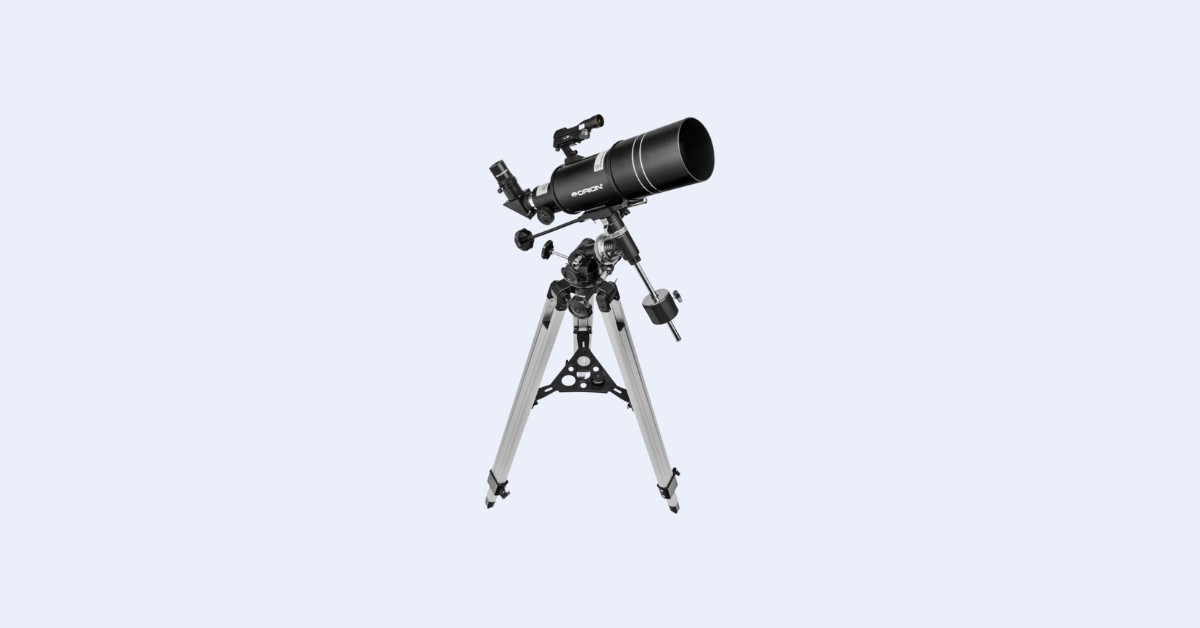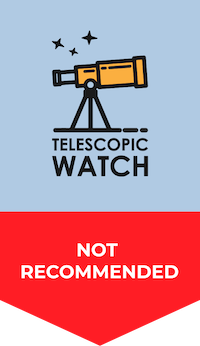Analysing Orion Observer 80ST’s Optical Tube
The 80ST is an 80mm f/5 achromatic refractor. Being a cheap fast achromat, I noticed the scope suffers from a lot of chromatic aberration, which results in blurry images at high magnifications (especially on the Moon and planets) and obnoxious purple halos around bright objects such as the Moon, planets, and bright stars. The 80ST suffers from quite a bit more chromatic aberration than its predecessor – so much so that it is basically unusable at magnifications of over 50x. You’re not going to be seeing much detail in the cloud belts of Jupiter and Saturn with this scope, nor the Cassini division, nor likely anything at all on Mars besides maybe its polar ice cap.
The 80ST’s lens, which I’ve inspected, is not multi-coated, unlike most decent telescopes in the modern era. It has a simple anti-reflection coating (if any at all-Orion claims there is one, but I can’t see any indication of it), which means it suffers a bit of a loss of light gathering ability compared to most other 80mm refractors and has more glare problems.
These glare problems are not helped by the horribly bad plastic focuser on the telescope. Nothing about it is metal except the screws. The drawtube is chrome-painted plastic, and the shiny chrome protrudes into the tube, causing all sorts of stray reflections. The inside is painted more of a dark gray than black and, as a result, allows for even more light to scatter. The drawtube is long enough that it also seems to actually clip part of the telescope’s light cone and induce vignetting, reducing its effective aperture and thus the telescope’s resolution and light-gathering ability. If this all wasn’t bad enough, the rack on the focuser is incredibly prone to stripping and damage, and sags under the weight of the eyepiece and diagonal, wobbling as you rack it in and out to focus. It is easily the worst part of the entire telescope.
Rather than using a dovetail, or at least tube rings like almost any decent telescope would use to attach to its mount, the 80ST uses a pair of bolts attached to the tube, which go through two holes on the mount and are fastened with wingnuts. Not only is this incredibly cheap and rather janky in appearance, but the wingnuts are all too easy to lose in the dark.
Reviewing the Accessories
The Observer 80ST comes with a 90-degree mirror star diagonal, a red dot finder, and two Kellner eyepieces—25mm and 10mm—providing 16x and 40x respectively.
The included mirror star diagonal is rather low-quality, and if the scope were actually capable of high magnifications, I’d complain about it a lot more. The whole body is plastic, and the mirror does not appear to be optically flat. It caused some astigmatism and other issues when I tested it with some other telescopes. At the low power that you’re limited to due to the scope’s other issues, however, it’s not really much of an issue. It is still incredibly disappointing, even considering the telescope’s rather low price.
The red dot finder included with the Observer is incredibly cheap. It is hard to adjust; you can’t get your eye up close to the reticle; the glass is tinted and makes everything dimmer; and sometimes it just stops working altogether for seemingly no reason. It is very much a cut below the regular “StarPointer” and “EZ Finder II” red dot sights—which are already incredibly cheap and ubiquitous on many beginner telescopes. Thankfully, the telescope itself has such a wide field of view at low power that you hardly need the red dot finder, but it’s still a nuisance. The finder is also mounted on a weird, non-standard bracket, which makes it almost impossible to replace without taking apart the telescope, removing the lower part of the bracket that is permanently attached, and probably drilling new holes to fit a standard finderscope shoe.
The included Kellner eyepieces are decent enough for the telescope. With a roughly 50-degree apparent field of view, they won’t be giving the widest fields possible with the telescope-but they’re plenty good for the price. My only gripe is the lack of rubber eyecups, which really help with positioning your eye properly above the lens.
The 80ST also comes with Orion’s MoonMap 260, which is a nice fold-out map showing most of the prominent lunar features that are visible with the telescope in both regular and left-right reversed (as seen in the eyepiece) views.
The EQ-1B Equatorial Mount
The EQ-1B is a slight variation on the same cheap EQ-1 mount that is supplied with good and bad beginner scopes alike. The main issue with the EQ-1 is that it tends to have more payload shoved on it than its meager frame can actually handle, which is thankfully not the case with the lightweight and tiny 80ST optical tube. The EQ-1B is a little cheaper than the regular EQ-1, however. It seems to use fewer screws to hold the tripod together and more cheap rivets, which are probably more susceptible to wear and damage with time. While it is still plenty solid and works fine, the equatorial motions can be confusing for a beginner and are completely unnecessary for a telescope that is designed for wide-field views and will not be used at high magnifications anyway. You can fit the mount with a “logic drive” or motor drive made by Celestron or Orion, but this is complete overkill for visual work, and neither the mount nor the telescope are good enough for serious astrophotography anyway.
Should I buy a Used Observer 80ST?
I’ve found the Observer 80ST is more likely to be frustrating than fun to use, so I wouldn’t recommend bothering with it unless you can get it for less than $60 or so.
Alternative Recommendations
While one shouldn’t be expecting perfection for an under-$200 telescope, the Observer 80ST is far from our first choice.
Under $200
- The Zhumell Z100 and Orion SkyScanner provide brighter views than the Observer 80ST free of chromatic aberration, with a similarly short focal length ideal for the ultra-wide field views of deep-sky objects that the 80ST is intended for. They also include significantly better eyepieces and provide much more pleasing views of planets and other small targets with a high-magnification eyepiece.
- The SarBlue Mak60 with Dobsonian Mount isn’t going to outperform the 80ST or a 100mm reflector on deep-sky objects, but provides great views of the Moon and planets with its sharp Maksutov-Cassegrain optics.
$200-$250
- The Zhumell Z114 provides significantly brighter and sharper views than the 80ST or other small-aperture options, with a set of well-made accessories and a short focal length for pleasing wide-field views – though its parabolic and collimatable primary mirror is no slouch on high-resolution targets like the Moon and planets either.
- The Orion StarBlast II 4.5 EQ combines the Z114 optical tube with the same EQ-1 mount as the 80ST; it’s a bit harder to use and less stable but if you must have a tripod and/or equatorial mount it will work fine and still provides pleasing views.
$250-$350
- The Sky-Watcher Heritage 150P, and its smaller sister, the Heritage 130P, have nearly double the aperture of the Observer 80ST, and thus significantly brighter and sharper views than the 80ST or any smaller telescopes. Both telescopes have sufficient resolving power and light grasp to resolve globular star clusters and planetary nebulae as more than mere featureless blobs as well as show a wealth of detail on the Moon and planets.
- The Orion StarBlast 4.5 Astro is another tabletop Dobsonian like the Z114 and shares the Z114/StarBlast optical tube. However, for the same price you could get the Heritage 150P or 130P instead, so unless these telescopes and the Z114 are unavailable it would not be our first choice.
- The Popular Science by Celestron StarSense Explorer DX 100AZ is the cheapest refractor we really like – it has good optics, good accessories, an`d ample aperture to show you stuff, atop a sturdy and easy-to-use mount – though the usual pitfalls of high price and chromatic aberration apply. It also features Celestron’s StarSense Explorer technology to make it easy to aim the telescope and find objects in the night sky.
Check out our rankings and top picks pages for more information.
What can you see with Orion Observer 80ST?
The 80ST isn’t very useful for even moderate magnifications, and as a result, you’re not going to be getting too many exciting views of the Moon and planets. The Moon will show a fair amount of detail, but it’s not very crisp. Jupiter’s moons are visible, but its cloud bands are ill-defined and the Great Red Spot is rather challenging to see. Saturn’s rings are visible, but you won’t be seeing the Cassini Division or any cloud belts, and the smaller moons besides Titan are not visible. Mars is a red fuzzy ball with maybe a hint of the polar ice cap around opposition. Mercury is a smudge, too small to distinguish its phase. Venus is a small gibbous or crescent orb, with a massive purple halo surrounding it due to the scope’s chromatic aberration. And forget Uranus or Neptune – you need at least 80x or so to distinguish them from stars, and the 80ST isn’t capable of such magnification.
Things are a bit better outside the solar system, but not much. While you can see the Orion Nebula, Andromeda Galaxy, a few other large emission nebulae and bright galaxies, and a fair number of star clusters, most deep-sky objects are smudges that are often rather dim-and any nearby lights will completely wreck the view thanks to the scope’s glare problems. Additionally, despite being an 80mm refractor, the 80ST somehow shows much dimmer and less impressive views than a 100mm tabletop reflector or 90mm Maksutov-Cassegrain, both of which theoretically have equal or less light gathering ability than the 80ST does-a problem I attribute to the scope’s glare/vignetting issues and the low-quality lens coatings. You won’t necessarily see nothing at all, but the views of what you can see are certainly unimpressive, even at the relatively low bar set by a sub-$200 telescope.




I’ve bought one for 168 quid it’s build quality is garbage I’ve basically thrown my money in the bin